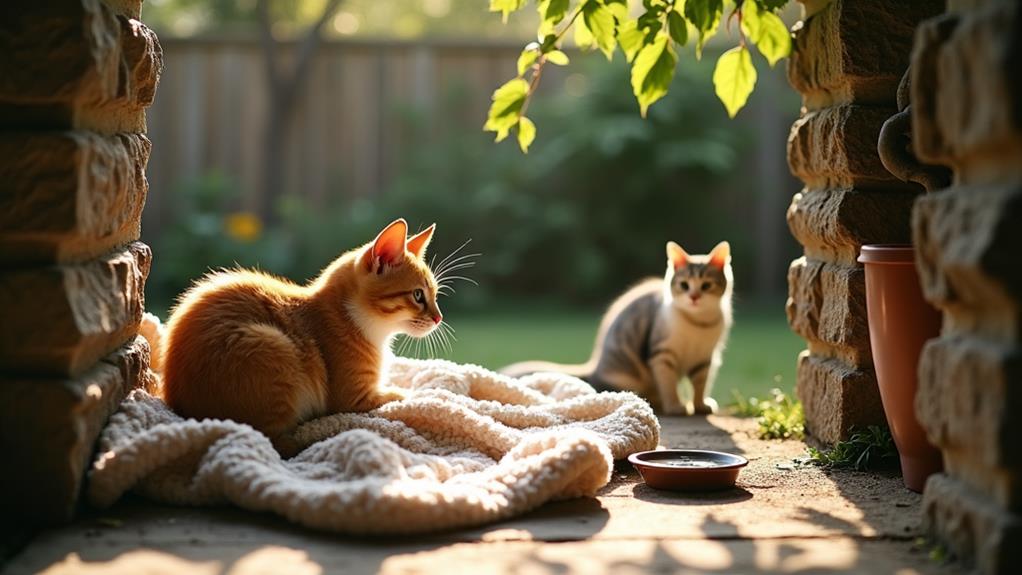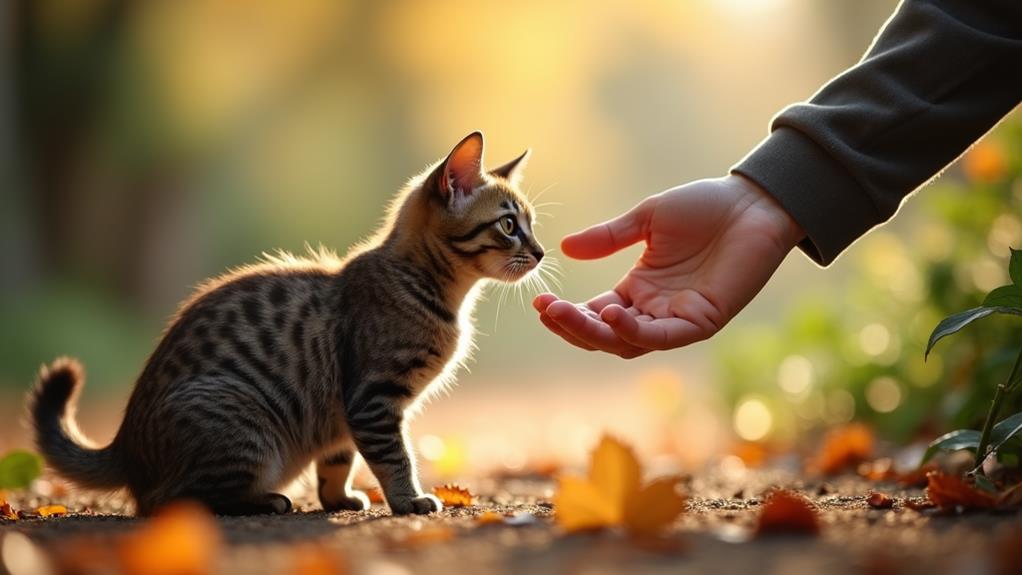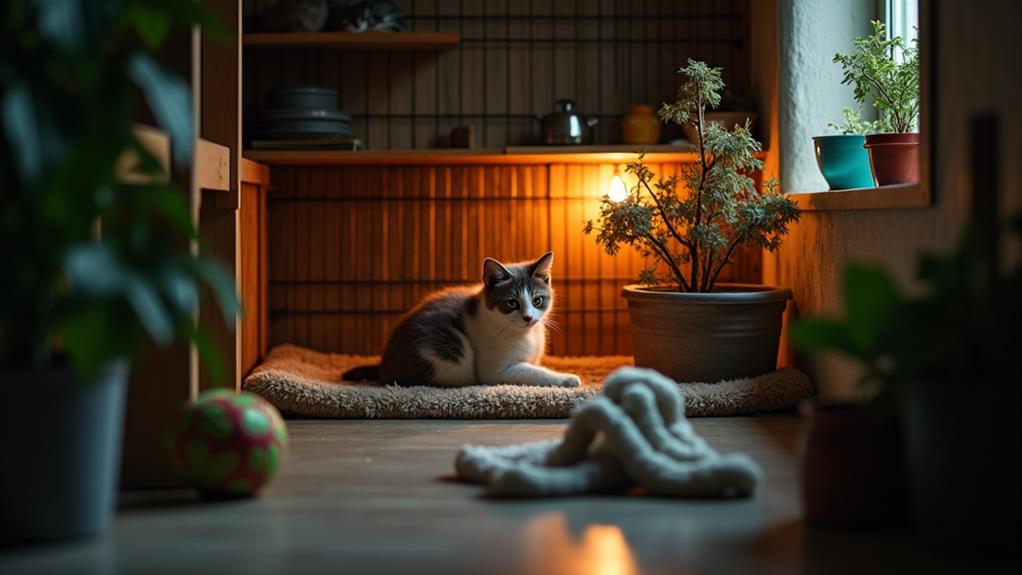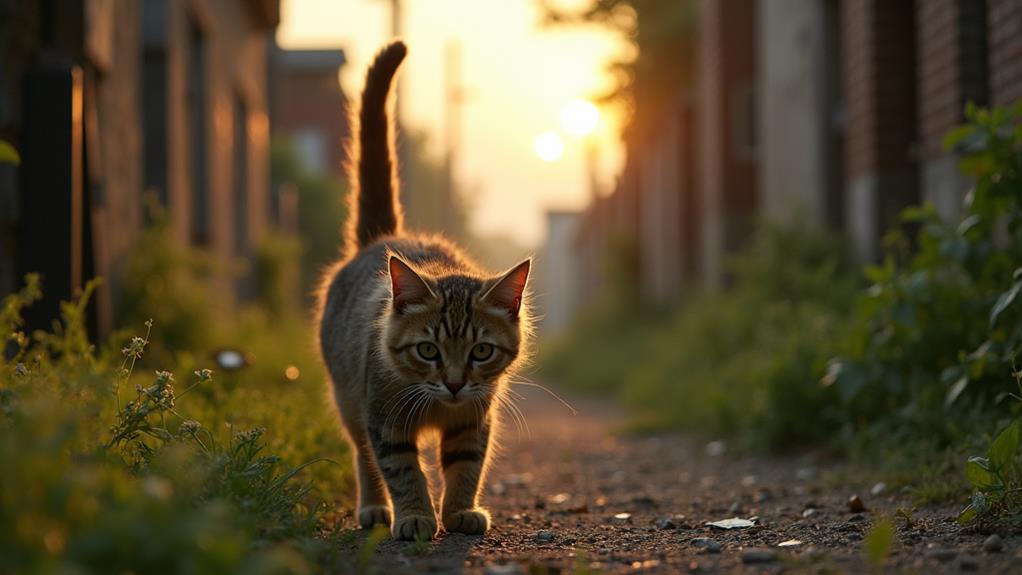How to Get a Feral Cat to Trust You: Building a Relationship Slowly

To get a feral cat to trust you, start by understanding their cautious nature. Use food as a tool; offer strong-smelling treats regularly to encourage their approach. Create a safe, quiet space where they can relax without stress. Engage them with play from a distance using wand toys, which mimics hunting and can build interest. When they're more comfortable, introduce gradual physical contact, allowing them to sniff your hand before petting. Be patient, and respect their pace to avoid setbacks. By doing this, you'll begin to form a bond and uncover more ways to deepen the relationship.
Understanding Feral Cat Behavior
Understanding feral cat behavior is fundamental if you want to build trust with these cautious creatures. Feral cats, driven by survival instincts, often appear fearful due to limited human interaction. Each cat has a distinct personality, and their past experiences greatly influence how quickly they might learn to trust you. Some cats may open up sooner, while others will require more time. It's imperative to respect their pace, as rushing can backfire, increasing their wariness instead of easing it.
To effectively communicate with feral cats, you need to pay close attention to their body language. Key indicators, such as the position of their tail and the orientation of their ears, offer insights into their comfort levels. For instance, a relaxed tail or forward-facing ears often signals a calm demeanor, while a tucked tail or flattened ears might indicate fear or anxiety.
Creating a safe environment is crucial. Feral cats need time to feel secure in their new surroundings, sometimes taking months before they are comfortable enough to investigate. By understanding their behavior and respecting their need for safety, you can gradually build a foundation of trust with them.
Building Trust With Food
In relation to building trust with feral cats, food is your most powerful ally. Offering food and water consistently is the best thing you can do to earn their trust. Strong-smelling treats, like tuna or wet food, can encourage their approach. Establishing a routine is essential, so feed them at the same time every day to create familiarity and security. Speak softly during feeding times to reassure them you're not a threat.
To deepen this trust, follow these steps:
- Consistency is Key: Stick to a regular feeding schedule. Cats thrive on routine, and predictability can help them feel safe.
- Slow Introduction: Slowly extend your hand without food, allowing the cat to sniff and become comfortable. This reinforces trust without overwhelming them.
- Avoid Petting During Meals: While hand-feeding can foster a bond, avoid petting initially. Cats may react defensively if they feel threatened during meals.
Monitor their behavior and adjust your approach as needed. With patience and dedication, you'll gradually earn their trust. Remember, food and water are merely the beginning of a lasting relationship. The goal is to create positive associations that encourage interaction every day.
Creating a Safe Space

After establishing trust through consistent feeding, it's time to focus on creating a safe space where the feral cat can feel secure and relaxed. Start by designating a quiet room in your home as the cat's sanctuary. This area should be free of high-traffic activity, which helps reduce anxiety and encourages exploration.
In this safe space, provide a cozy bed for the feral cat. You can improve their sense of security by including familiar scents, such as a piece of your worn clothing. This comforting aroma can ease the cat's adjustment into their new environment. It's crucial to place feeding and litter areas strategically, away from busy spots, to minimize stress.
Limit the cat's exposure to unfamiliar people and pets, as this can help them acclimate without feeling threatened. This dedicated area should remain tranquil and consistent, promoting trust as the cat learns to navigate their surroundings. Regularly check for potential hazards that might disrupt the calm atmosphere. By ensuring a safe and secure space, you're setting the stage for a trusting relationship that can grow over time, easing the feral cat's anxiety and helping them feel at home.
Encouraging Playful Interaction
To start encouraging playful interaction with a feral cat, use wand toys or string toys placed on the floor to gently engage their interest. This approach allows the cat to interact at a distance they find comfortable, fostering trust gradually. Observe how the cat responds to different play styles; some cats might be intrigued by a flick of a string, while others may prefer a more subtle approach.
Make sure the environment remains calm and non-threatening. When introducing playful interaction, avoid sudden movements or loud noises that might scare the cat. Instead, create a safe space where the cat feels secure to investigate and play.
Consistently scheduling playtime every day is essential. Regular interactions can help build trust and strengthen your bond over time. Consider using simple objects that stimulate their natural instincts, like pine cones or rattling mice.
Here's how to improve playful engagement:
- Observe and Adapt: Notice the cat's reactions and adjust your play techniques accordingly.
- Routine Matters: Consistency in playtime helps establish a sense of security.
- Stimulate Curiosity: Use toys that encourage natural hunting and investigation instincts.
Gradual Physical Contact

Building trust with a feral cat through gradual physical contact requires patience and sensitivity. Start by making small gestures, like allowing the cat to sniff your hand before you attempt to touch them. This helps build initial trust without overwhelming the cat. Timing is everything; wait until the cat is calm and relaxed before initiating any petting. This guarantees the experience is positive and reinforces your presence as non-threatening.
When you're ready to begin petting, keep the sessions short. This prevents overstimulation and stress, which are essential in maintaining the cat's growing trust in you. Gradually increase the duration of petting as the cat becomes more accustomed to your touch. Focus on areas that cats typically enjoy, like under the chin and behind the ears, to promote positive feelings and further reinforce trust.
To create a positive association with touch, pair petting sessions with treats. This helps the cat learn that your presence is both safe and rewarding. By consistently associating your touch with treats, you make the process enjoyable and help the feral cat feel more comfortable around you. Remember, patience and sensitivity are your best tools.




